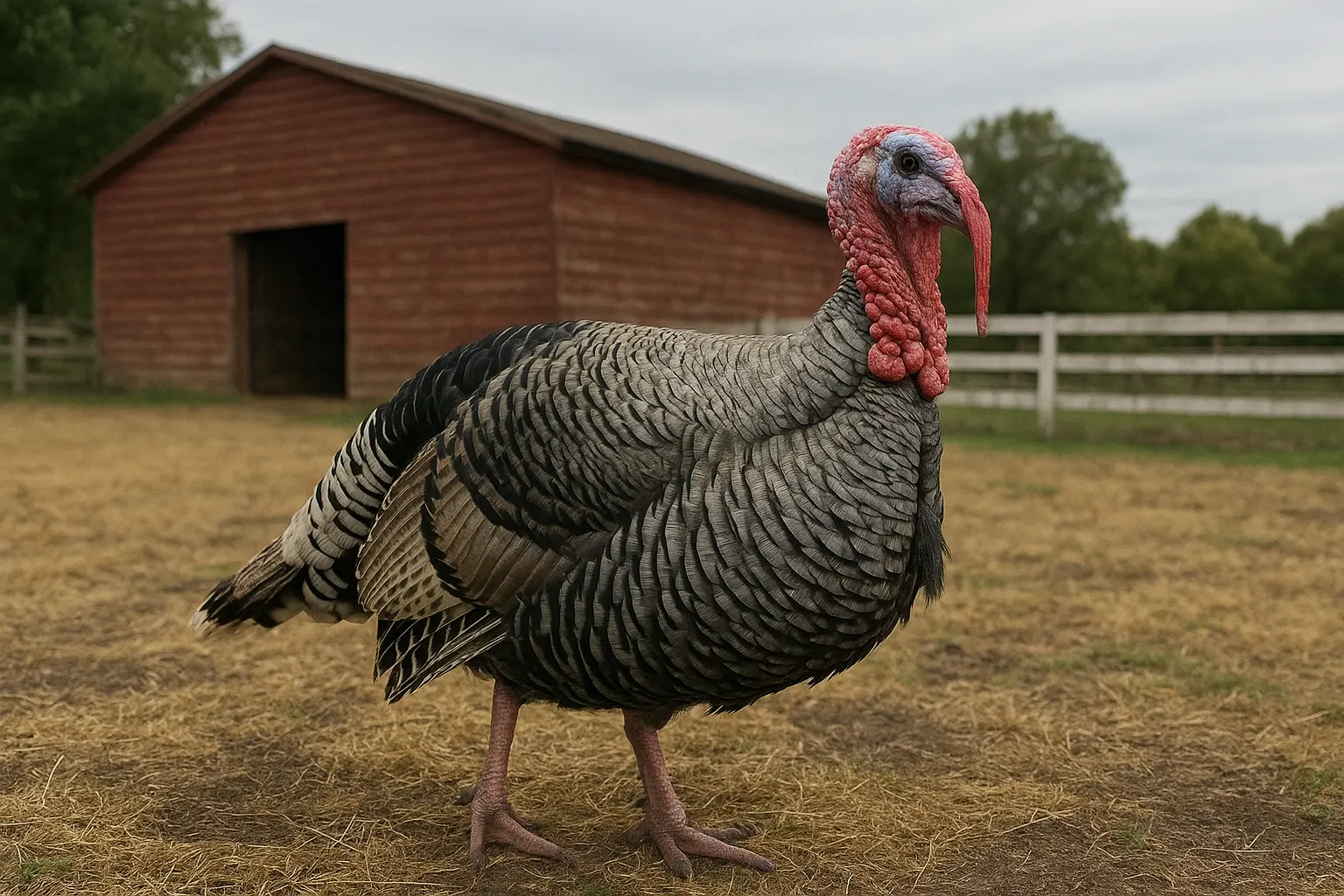
Common Health Conditions in Chickens: What Every Poultry Keeper Should Know
Keeping chickens can be an incredibly rewarding experience, whether you're running a smallholding, managing a backyard flock, or overseeing a larger poultry operation. However, as with any animals, chickens are prone to various health conditions. Early detection, preventive care, and appropriate treatment are essential to ensure your birds remain healthy and productive.
This guide outlines the most common chicken health issues, their symptoms, causes, treatments, and preventive measures.
Marek’s Disease
Overview
Marek’s disease is a highly contagious viral illness caused by a herpesvirus. It primarily affects young chickens and can lead to paralysis and tumours.
Symptoms
- Progressive paralysis (wings, legs, neck)
- Weight loss
- Tumours in internal organs
- Blindness (in ocular form)
- Irregular pupils
Transmission
- Spread through dander and feather debris
- Enters via inhalation
Treatment
- No cure once infected
- Euthanasia is often recommended for affected birds
Prevention
- Vaccinate chicks at day-old
- Maintain strict biosecurity
- Keep brooder areas clean and dry
Coccidiosis
Overview
Coccidiosis is a parasitic disease caused by protozoa, common in young or stressed birds.
Symptoms
- Bloody or watery diarrhoea
- Lethargy
- Drooping wings
- Pale combs
- Poor growth
Transmission
- Ingesting contaminated litter or feed
- Poor hygiene and overcrowding increase risk
Treatment
- Anticoccidial medications (e.g., Amprolium)
- Isolate affected birds
Prevention
- Use medicated chick starter feed
- Regularly clean housing
- Rotate pasture if free-ranging
Infectious Bronchitis
Overview
Infectious bronchitis is a viral respiratory disease affecting chickens of all ages. It spreads rapidly and affects the respiratory tract, reproductive system, and kidneys.
Symptoms
- Sneezing and coughing
- Nasal discharge
- Watery eyes
- Drop in egg production
- Misshapen or thin-shelled eggs
Transmission
- Airborne or via contaminated equipment and clothing
Treatment
- No specific antiviral treatment
- Provide supportive care (warmth, fluids, vitamins)
Prevention
- Vaccination
- Strong biosecurity protocols
- Good ventilation in coops
Avian Influenza
Overview
Avian influenza is a highly contagious viral disease with the potential to cause large-scale outbreaks and high mortality rates.
Symptoms
- Sudden death
- Swollen comb and wattles
- Respiratory distress
- Diarrhoea
- Nervous signs (in severe cases)
Transmission
- Wild birds are major carriers
- Spread through droppings, saliva, or contaminated equipment
Treatment
- No treatment; notifiable disease
- Flocks may need to be culled
Prevention
- Keep chickens away from wild birds
- Implement strict quarantine and hygiene protocols
- Report suspected cases to authorities
Fowl Pox
Overview
Fowl pox is a slow-spreading viral disease in two forms: dry (cutaneous) and wet (diphtheritic).
Symptoms
- Scabby lesions on comb, wattles, and beak
- Yellow plaques inside mouth or windpipe (wet form)
- Drop in appetite and egg laying
Transmission
- Spread via mosquito bites or contact with scabs
Treatment
- Supportive care
- Remove affected birds during outbreaks
Prevention
- Vaccinate birds, especially in mosquito-prone areas
- Control insect populations
Infectious Laryngotracheitis (ILT)
Overview
ILT is a serious respiratory disease caused by a herpesvirus.
Symptoms
- Gasping and coughing
- Nasal and eye discharge
- Blood-stained mucus
- Drop in egg production
Transmission
- Spread through respiratory secretions and equipment
Treatment
- No specific treatment
- Supportive care and culling of severe cases
Prevention
- Vaccination
- Isolate new birds and maintain biosecurity
Botulism
Overview
Botulism is a potentially fatal illness caused by toxins from Clostridium botulinum bacteria.
Symptoms
- Sudden flaccid paralysis
- Limp neck (limberneck)
- Inability to walk, eat or drink
- Death within hours in severe cases
Causes
- Ingesting decaying organic matter or contaminated carcasses
Treatment
- Antitoxin if caught early
- Supportive care with fluids and feeding
Prevention
- Keep run and coop free of dead animals and rotting materials
Egg Binding
Overview
Egg binding occurs when a hen is unable to pass an egg. It can be life-threatening if not addressed quickly.
Symptoms
- Straining
- Lethargy
- Swollen abdomen
- Tail down posture
- Loss of appetite
Causes
- Poor nutrition (lack of calcium)
- Overweight hens
- Young or older birds
- Large or misshapen eggs
Treatment
- Warm baths and gentle massage
- Calcium supplements
- Veterinary intervention may be necessary
Prevention
- Provide a well-balanced diet with adequate calcium
- Maintain good body condition
- Reduce stress in laying hens
Scaly Leg Mites
Overview
Scaly leg mites are microscopic parasites that burrow under the scales on a chicken’s legs and feet.
Symptoms
- Raised, crusty leg scales
- Lameness
- Swelling and inflammation
- Thickened legs over time
Transmission
- Spread through contact with infested birds or housing
Treatment
- Soak and gently scrub legs
- Apply topical treatments (e.g., ivermectin, petroleum jelly)
- Disinfect coop and perches
Prevention
- Regular health checks
- Maintain clean and dry living conditions
- Quarantine new birds
Bumblefoot
Overview
Bumblefoot is a bacterial infection (often Staphylococcus) of the foot, usually entering through a cut or abrasion.
Symptoms
- Swollen footpad
- Hard, black scab
- Limping
- Reluctance to perch or walk
Causes
- Rough or dirty perches
- Sharp objects in the run
- Obesity and inactivity
Treatment
- Clean wound and apply antiseptics
- In severe cases, veterinary surgery may be needed
- Antibiotics if prescribed
Prevention
- Provide soft, smooth perches
- Inspect runs and coops for sharp objects
- Keep bedding clean and dry
Worm Infestation
Overview
Chickens can be affected by several internal parasites, including roundworms, tapeworms, and gapeworms.
Symptoms
- Weight loss
- Pale combs
- Diarrhoea
- Poor egg production
- Gasping (in gapeworm infections)
Transmission
- Picking up parasite eggs from droppings or soil
Treatment
- Use poultry-approved wormers (e.g., Flubenvet)
- Repeat treatment as advised
Prevention
- Rotate grazing areas
- Clean droppings frequently
- Conduct regular faecal checks
External Parasites: Lice and Mites
Overview
External parasites are a common issue, particularly in warm or crowded environments.
Symptoms
- Feather loss
- Excessive preening
- Irritated or red skin
- Decreased egg production
- Visible lice or mites, especially around vent
Types
- Red mites (feed at night)
- Northern fowl mites
- Poultry lice
Treatment
- Dust or spray with poultry-safe insecticides
- Repeat treatments to break lifecycle
- Clean and treat coop, especially cracks and perches
Prevention
- Regular inspections
- Diatomaceous earth in dust baths
- Good coop hygiene
Newcastle Disease
Overview
Newcastle disease is a serious viral disease that affects the respiratory, digestive, and nervous systems.
Symptoms
- Coughing, sneezing, gasping
- Diarrhoea
- Twisted neck (torticollis)
- Paralysis
- Drop in egg production
Transmission
- Direct contact with infected birds or materials
- Contaminated equipment or humans
Treatment
- No cure available
- Supportive care only
Prevention
- Vaccination
- Quarantine new birds
- Biosecurity measures
Infectious Coryza
Overview
Infectious coryza is a bacterial disease causing upper respiratory infection, especially in adult birds.
Symptoms
- Swelling of the face and wattles
- Foul-smelling nasal discharge
- Sneezing and conjunctivitis
- Decreased feed intake and egg production
Transmission
- Direct contact or through contaminated feed, water, or bedding
Treatment
- Antibiotics may help but birds remain carriers
- Cull in severe outbreaks
Prevention
- Quarantine new additions
- Keep water and feeders clean
- Avoid overcrowding
Mycoplasma (CRD)
Overview
Chronic respiratory disease (CRD) is caused by Mycoplasma gallisepticum, often in combination with other infections.
Symptoms
- Coughing and nasal discharge
- Swollen sinuses
- Conjunctivitis
- Slow growth or poor egg production
Transmission
- Bird-to-bird contact
- Contaminated equipment
Treatment
- Antibiotics can control symptoms
- Birds often remain carriers
Prevention
- Obtain stock from disease-free sources
- Isolate sick birds
- Practice strict biosecurity
Crop Impaction
Overview
Crop impaction occurs when the crop becomes blocked by indigestible material.
Symptoms
- Full, hard crop even in the morning
- Reduced appetite
- Lethargy
- Sour-smelling breath
Causes
- Eating long grass, hay, or foreign objects
Treatment
- Gentle massage and administering vegetable oil
- Surgical removal in severe cases
Prevention
- Monitor access to long grass
- Provide grit to aid digestion
Sour Crop
Overview
Sour crop is a yeast infection (usually Candida albicans) in the crop.
Symptoms
- Foul-smelling breath
- Squishy, enlarged crop
- Lethargy
- Loss of appetite
Causes
- Overeating, poor diet, or crop impaction
Treatment
- Withhold food for 24 hours, offer water with apple cider vinegar
- Administer antifungal treatment
Prevention
- Clean feeders and waterers
- Provide balanced diet
Heat Stress
Overview
Heat stress occurs when chickens cannot regulate their body temperature in hot conditions.
Symptoms
- Panting and spreading wings
- Lethargy
- Reduced egg production
- Collapse or death in extreme cases
Treatment
- Move birds to shade
- Provide cool water with electrolytes
- Mist lightly with water
Prevention
- Provide ventilation and shade
- Use frozen treats and fresh water
Vent Gleet (Cloacitis)
Overview
Vent gleet is a yeast or bacterial infection of the vent area.
Symptoms
- Foul-smelling discharge around the vent
- Dirty feathers
- Red, swollen vent
- Decreased egg laying
Treatment
- Clean vent with saline
- Apply antifungal or antibacterial ointment
- Offer probiotic supplements
Prevention
- Maintain hygiene and stress-free environment
- Feed a balanced diet
Twisted Neck (Wry Neck)
Overview
Wry neck is a neurological condition where the bird cannot hold its head upright.
Symptoms
- Twisting of the head and neck
- Inability to eat or drink normally
- Rolling or walking in circles
Causes
- Vitamin E deficiency
- Head injury
- Certain viral infections
Treatment
- Administer vitamin E and selenium supplements
- Supportive care and isolation
Prevention
- Feed a complete, vitamin-rich diet
- Avoid overcrowding and rough handling
Gumboro Disease (Infectious Bursal Disease)
Overview
Gumboro is a viral disease affecting the immune system of young chickens.
Symptoms
- Ruffled feathers
- Diarrhoea
- Trembling
- Dehydration
- Immunosuppression leading to other infections
Transmission
- Through droppings and contaminated surfaces
Treatment
- No specific cure; supportive care
Prevention
- Vaccinate chicks
- Maintain hygiene and biosecurity
Erysipelas
Overview
Erysipelas is a bacterial infection caused by Erysipelothrix rhusiopathiae.
Symptoms
- Sudden death
- Swollen joints
- Darkened combs
- Lameness
Transmission
- Contaminated soil, water, or dead birds
Treatment
- Antibiotics such as penicillin
- Isolate affected birds
Prevention
- Rotate pastures
- Dispose of carcasses promptly
- Vaccination available in some areas
Conclusion
Understanding the full spectrum of common and uncommon health conditions that affect chickens is essential for any poultry keeper. Early recognition and proper management can mean the difference between life and death for a bird, or between a minor setback and a flock-wide outbreak. Regular observation, clean housing, appropriate nutrition, vaccinations, and strict biosecurity are your best defences against disease. Always consult a poultry-savvy vet if you’re unsure—your flock’s health depends on it.
Contents
- Marek’s Disease
- Coccidiosis
- Infectious Bronchitis
- Avian Influenza
- Fowl Pox
- Infectious Laryngotracheitis (ILT)
- Botulism
- Egg Binding
- Scaly Leg Mites
- Bumblefoot
- Worm Infestation
- External Parasites: Lice and Mites
- Newcastle Disease
- Infectious Coryza
- Mycoplasma (CRD)
- Crop Impaction
- Sour Crop
- Heat Stress
- Vent Gleet (Cloacitis)
- Twisted Neck (Wry Neck)
- Gumboro Disease (Infectious Bursal Disease)
- Erysipelas
- Conclusion
Tags
Related Vets
Vets near you
Speciality vets
- Aquatics vet specialists
- Birds vet specialists
- Camelids vet specialists
- Cats vet specialists
- Cattle vet specialists
- Deer vet specialists
- Dogs vet specialists
- Equines vet specialists
- Exotic vet specialists
- Goats vet specialists
- Pigs vet specialists
- Poultry vet specialists
- Sheep vet specialists
- Small Mammals vet specialists
- Wild vet specialists











